Sorry, I know I promised to post this Wednesday, but I needed to post the final HSF challenge and the Robe de Cour terminology post instead!
So here, without further ado, is my (finally) finished 1860s elliptical hoopskirt:
I based it (roughly) on this hoopskirt at the V&A, because I was so excited by the red twill tape that I found, and I love the idea of having a red hoopskirt instead of the usual basic white ones.
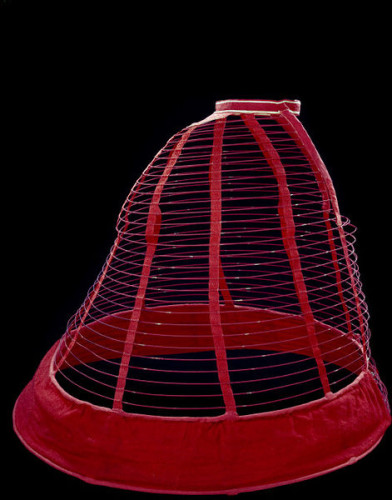
Cage crinoline, Great Britain, 1860-1865, Spring steel, woven wool, linen, lined with cotton, and brass, Victoria & Albert Museum T.150-1986
Sadly, I don’t feel mine is as pretty as its inspiration, though it does look better on me than on Isabella the dressform.
I’m hoping I’ll warm up to it, because I was so excited about the project, and expended such a lot of effort on it. Each tape had to be individually hand-sewn to each hoop.
And even before that, there was the shoving of metres of hoop wire into metres of sewn-tape casing, and since the wires are very snug in their tape channels, I got rather sore arms.
I think my next project needs to be something simple and fun that does NOT involve hand sewing!
Still, it finally means I have a hoopskirt that looks right under the Greek Key ensemble, and that’s been a long time coming:
The Challenge: #19: Wood, Metal, Bone
Fabric: 1/2 metre red cotton homespun ($1), 1/2 metre cotton flannel (recycled from a vintage obi).
Pattern: None, based on extant examples
Year: 1859-60. The years of the largest hoopskirts.
Notions: 24ish metres of red cotton twill tape (found at an op shop $1 for the roll), 17ish metres of hoop wire (NZ$50 or thereabouts), thread (and lots of it).
How historically accurate is it? The silhouette is right with a skirt worn over it, but I’m rather disappointed in how it looks. The hoop wires are definitely too wide for historical accuracy. However, there is an enormous range in the style and materials of mid-19th century hoopskirts, and considerable evidence that women used whatever they could afford to achieve the silhouette, so the whole effect is plausible.
Hours to complete: 15. Every single join, and there are 30 of them, had to be hand-sewn, and they took more than five minutes to do each one.
First worn: Not yet, but I’m hoping this means I’ll finally find an excuse to wear the Greek Key frock myself.
Total cost: NZ$52 – which is actually really reasonable, all things considered
Most importantly, how does the resident cat feel about it?
She approves:
She particularly liked it when I was still working on it and there were lots of dangly tapes to tempt her:

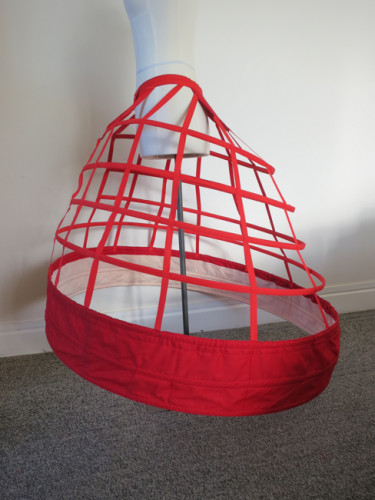
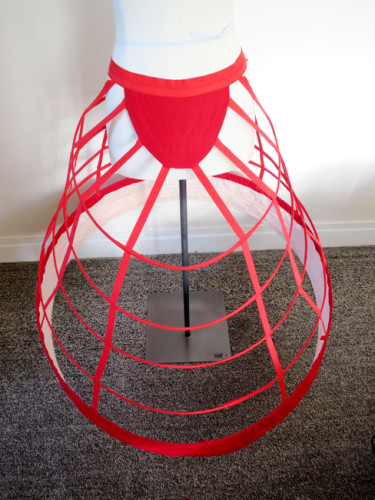

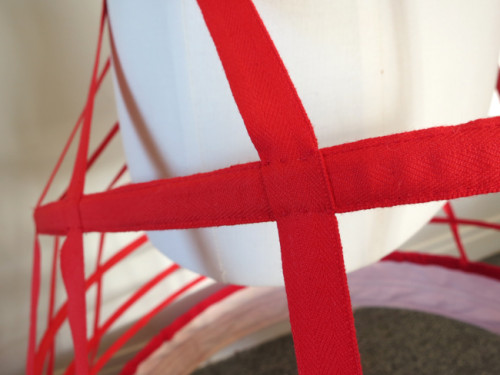
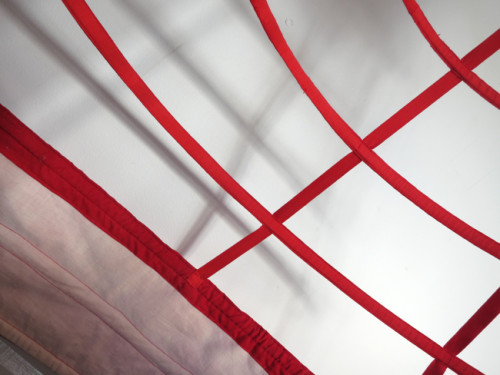
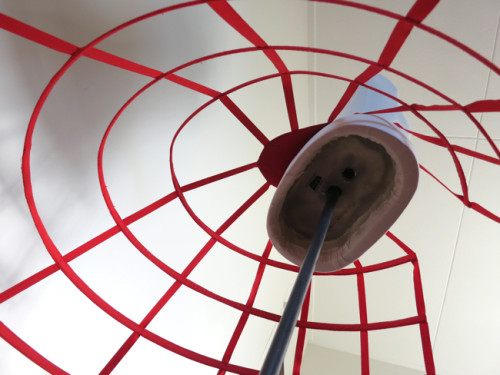
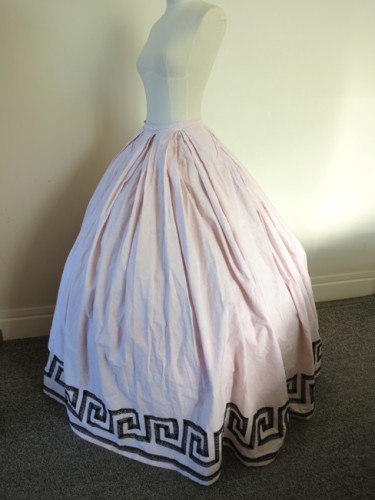
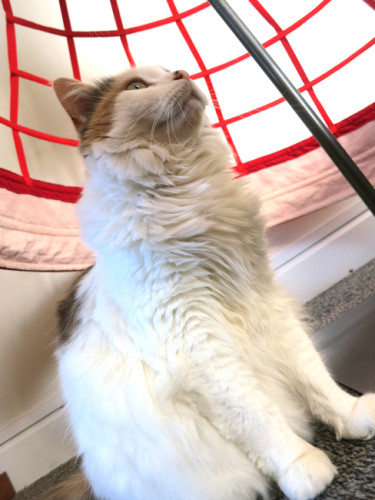
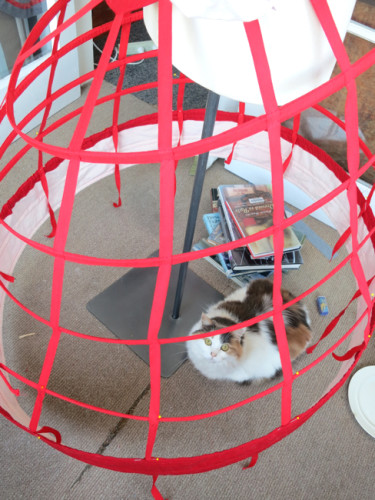
Lots of petticoats and possibly a bum pad will be very helpful for the shape. Lovely job!
Thanks Melissa. I’m actually very happy with the shape – it looks very similar to what you see in photographs from 1859-62. I’ll put a bum pad with it if I’m using it for slightly later 1860s styles, when a slight bustle starts to appear.
It is a *red* hoopskirt. A hand-stitched, and, I repeat, RED hoopskirt. I’m completely in love with it, and if it were in my power to do so, I’d command you to be in love with it also. Seeing this project made my day! 🙂
And, what I wouldn’t give to find some red twill tape around these parts…though I did find some chartreuse twill tape a while back, and it’s really beautiful.
Well, you could always dye white twill tape red! Chartreuse sounds pretty amazing though.
Aww <3 Thanks Kathryn!
It's not fully hand-stitched - only the joins where the hoops meet the tapes. I'm not that ambitious!
Hah! That’s completely fair. Either way, it’s glorious. So much so that I would leave it on my dress form to admire whenever I didn’t need the form for other work. 🙂
I’m with Kathryn – it is just beautiful!
Thank you Lynne!
Looks awesome, L! I wanna try it on (I’ve never worn a hoop skirt).
Thank you Theresa! You can try it next time you’re in Wellington! You’re due back for a photoshoot!
I’ve never paid much attention to the hoop skirt before, but yours is so striking, I love it!
Wow, thanks Susie!
It’s so pretty! I love the colour. This is so much cooler than a white hoop skirt.
The selection of boning available in this century is pretty disappointing though. Does anyone even make that covered spring steel stuff anymore?
I made a cage crinoline about 8 years ago that used sprung steel ribbon wire covered in fabric (meaning that there was a narrow wire on each side and none in the center). To get that really narrow width often seen in extant garments I cut down the middle and used each wire separately. The effect is pretty good, scale-wise, but the fabric covering did start wanting to come off after a few wears, so I had to hand wrap thread all the way around each wire to get it to look nice… lots of work. But now they’re great and get used all the time. All that to say that yes, it is possible to get covered spring steel these days, even if it is a challenge to find and use. 🙂
The color is lovely! What a fun 1860s surprise when the wind blows. 😉 I especially love the picture looking up from underneath. It’s very artsy (in a good way) and interesting. Having hand sewn my own hoops I can sympathize with all the hand sewing required. I love the open cage crinolines so much more than the entirely fabric ones, though.
Woo hoo for being done!
Best,
Quinn
Love it! I don’t costume during this era but I can totally appreciate the amount of work and the gorgeous finished product (and the cat…naughty animals and their penchant for dangly things…or expensive fabric…or chewing holes smack in the middle of a wide expanse of fabric you need to stay whole…)!
I love all the close up photos, your work is beautiful – and of course resident cat is lovely too. Oh how they love the dangly things!